- Strona główna
- O nas
- Branża
- Usługi
- Czytanie
- Kontakt
Rynek Automatyzacji Fabryk: Aktualna Analiza i Prognoza (2024-2032)
Nacisk na Komponent (Roboty Przemysłowe, Wizja Maszynowa, Analizatory Procesów, Instrumenty Terenowe, Interfejsy Człowiek-Maszyna, Komputery Przemysłowe, Czujniki Przemysłowe i Drukarki 3D Przemysłowe); Rozwiązanie (Rozproszony System Sterowania (DCS), Programowalny Sterownik Logiczny (PLC), System Nadzoru i Akwizycji Danych (SCADA), System Realizacji Produkcji (MES), Planowanie Zasobów Przedsiębiorstwa (ERP) i Inne); Przemysł Użytkownika Końcowego (Motoryzacja, Elektronika & Półprzewodniki, Przemysł Ciężki, Pakowanie, Ropa, Gaz i Chemia, Opieka Zdrowotna i Inne); oraz Region/Kraj
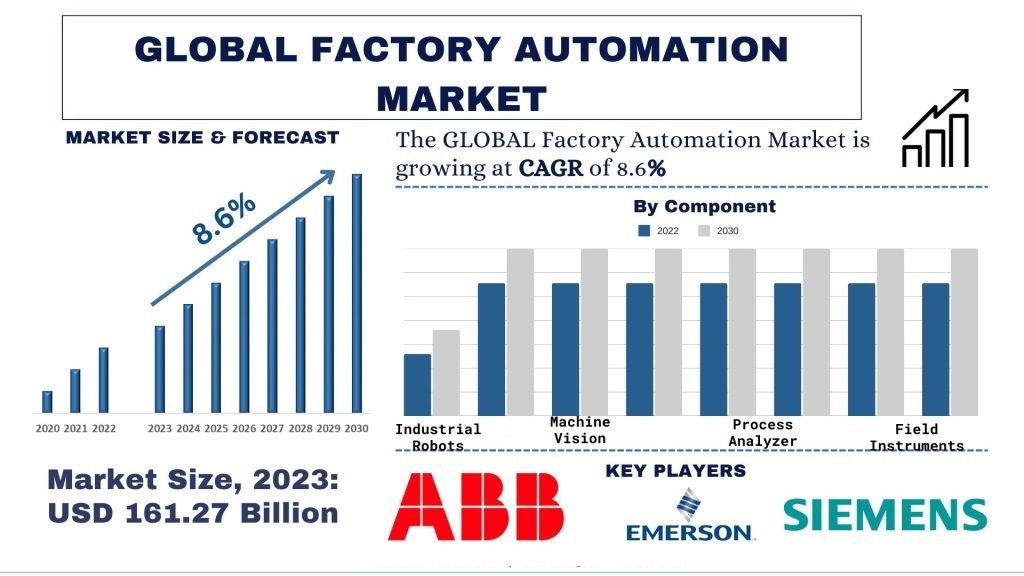
Wielkość i Prognoza Rynku Automatyzacji Fabryk
Globalny rynek automatyzacji fabryk został oszacowany na 161,2 miliarda USD i oczekuje się, że będzie rósł ze znaczącym CAGR na poziomie około 8,6% w okresie prognozy (2024-2032) ze względu na rosnące zapotrzebowanie na zwiększenie produkcji i efektywności operacyjnej, mające na celu minimalizację kosztów przy jednoczesnym utrzymaniu jakości.
Analiza rynku automatyzacji fabryk
Automatyzacja fabryk odnosi się do wykorzystania systemów sterowania, maszyn i technologii w celu usprawnienia procesów produkcyjnych, zmniejszając potrzebę interwencji człowieka przy jednoczesnej optymalizacji wydajności produkcji. Obejmuje automatyzację zadań tradycyjnie wykonywanych przez ludzi, przy użyciu maszyn, siłowników, czujników, procesorów i sieci w celu automatyzacji procesów produkcyjnych. Historia automatyzacji fabryk rozpoczęła się od podstawowych mechanizmów, takich jak przenośniki taśmowe na liniach montażowych, ewoluując do zaawansowanych systemów robotycznych i sterowania komputerowego.
Automatyzacja fabryk, integracja zaawansowanych technologii z procesami produkcyjnymi, odnotowuje niezwykły wzrost w różnych branżach. Ta transformacyjna zmiana jest napędzana przez wiele czynników, które zmieniają sposób funkcjonowania fabryk. Od zwiększania efektywności i produktywności po rozwiązywanie problemów z brakiem siły roboczej i poprawę jakości produktów, automatyzacja fabryk staje się czynnikiem zmieniającym zasady gry w krajobrazie produkcyjnym. Ponadto producenci są pod stałą presją, aby optymalizować swoje operacje i maksymalizować wydajność przy jednoczesnej minimalizacji kosztów na dzisiejszym, wysoce konkurencyjnym rynku globalnym. Zautomatyzowane systemy mogą działać przez całą dobę przy minimalnych przestojach, co skutkuje wyższymi wskaźnikami produkcji i poprawą ogólnej efektywności wyposażenia (OEE).Na przykład, zgodnie z raportem Międzynarodowej Federacji Robotyki (IFR), wdrożenie robotów przemysłowych doprowadziło do średniego wzrostu produktywności o 15-30% w różnych branżach. Dodatkowo, wiele branż, szczególnie w gospodarkach rozwiniętych, boryka się z niedoborem wykwalifikowanej siły roboczej z powodu starzejącego się społeczeństwa i zmieniających się trendów demograficznych. Technologie automatyzacji mogą złagodzić to wyzwanie, przejmując powtarzalne, fizycznie wymagające lub niebezpieczne zadania, zmniejszając zależność od pracy ludzkiej.Według szacunków koszty pracy stanowią do 25% całkowitych kosztów produkcji w krajach rozwiniętych, co napędza wdrażanie automatyzacji w celu utrzymania konkurencyjności. Co więcej, zautomatyzowane systemy są wysoce precyzyjne i spójne, zmniejszając ryzyko błędu ludzkiego i zapewniając spójną jakość produktu. Branże takie jak motoryzacja, elektronika i farmaceutyka, gdzie kontrola jakości ma kluczowe znaczenie, coraz częściej wdrażają automatyzację, aby spełnić rygorystyczne standardy jakości.Na przykład, według badania przeprowadzonego przez Association for Manufacturing Technology (AMT), 70% producentów wskazało poprawę jakości produktu jako kluczowy czynnik napędzający wdrażanie rozwiązań automatyzacji.Wreszcie, rewolucja Przemysłu 4.0, która promuje cyfryzację i wzajemne połączenie procesów produkcyjnych, przyspieszyła wdrażanie technologii automatyzacji. Inteligentne fabryki, umożliwione przez IoT, systemy cyber-fizyczne i przetwarzanie w chmurze, wykorzystują automatyzację do osiągnięcia monitoringu w czasie rzeczywistym, podejmowania decyzji w oparciu o dane i elastycznych możliwości produkcyjnych.
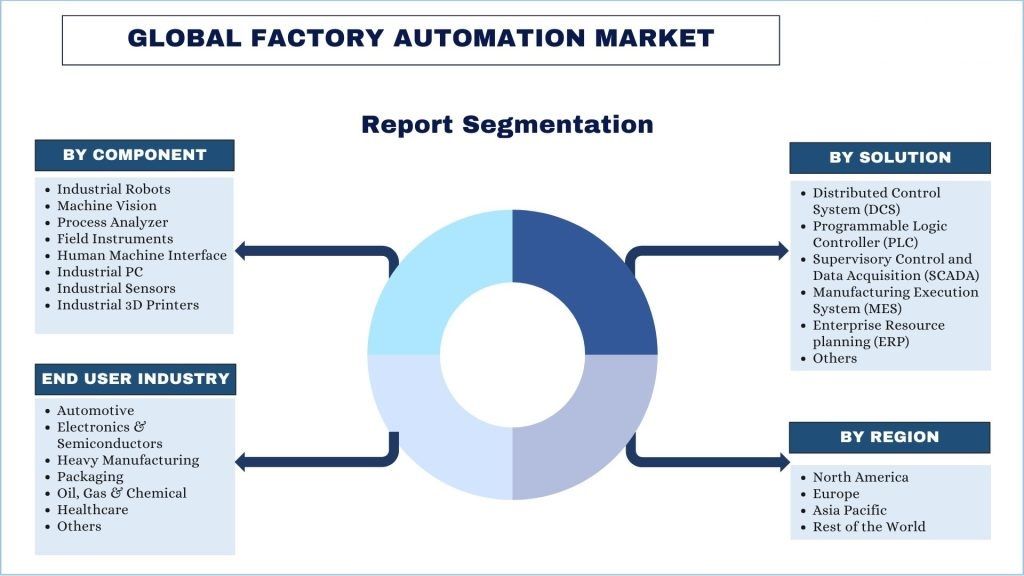
Trendy na rynku automatyzacji fabryk
Niniejsza sekcja omawia kluczowe trendy rynkowe, które wpływają na różne segmenty rynku automatyzacji fabryk, zidentyfikowane przez nasz zespół ekspertów ds. badań.
Roboty przemysłowe na stałe ugruntowały swoją pozycję jako kręgosłup przemysłu automatyzacji fabryk na całym świecie.
Roboty przemysłowe są najszerzej stosowane i cieszą się dużym popytem. Roboty przemysłowe na stałe ugruntowały swoją pozycję jako kręgosłup nowoczesnej automatyzacji fabryk. Te wysoce wszechstronne maszyny mogą wykonywać różne zadania z niezrównaną precyzją, szybkością i spójnością. Od montażu i spawania po przenoszenie materiałów i pakowanie, roboty przemysłowe stały się niezbędnymi aktywami w różnych branżach, w tym w motoryzacji, elektronice i dobrach konsumpcyjnych. Dominacja robotów przemysłowych może być przypisana ich potencjałowi zwiększania produktywności i wydajności. Roboty przemysłowe pomagają w poprawie produktywności, obniżaniu kosztów i generowaniu wysokiej jakości towarów w zastosowaniach automatyzacji. Ponadto postęp technologiczny odegrał znaczącą rolę we wdrażaniu robotów przemysłowych. Rozwój technologii bezprzewodowej 5G i przyjęcie Przemysłu 4.0 napędziły popyt na rozwiązania automatyzacji fabryk. Przemysłowy Internet Rzeczy (IIoT) jest niezbędny dla technologii automatyzacji, ponieważ ułatwia rozwój wydajnych, opłacalnych i responsywnych architektur systemowych. Czynniki takie jak te sprzyjają sprzyjającemu środowisku i wspierają wzrost wdrażania robotów przemysłowych do automatyzacji fabryk w różnych branżach.
Region Azji i Pacyfiku wyłania się jako najszybciej rozwijający się rynek automatyzacji fabryk na świecie.
W regionie Azji i Pacyfiku kraje takie jak Chiny, Indie, Korea Południowa, Japonia i Indie ugruntowały swoją pozycję jako liderzy we wdrażaniu automatyzacji fabryk w celu uzyskania przewagi konkurencyjnej na rynkach globalnych.
Oczekuje się, że region Azji i Pacyfiku doświadczy znacznego wzrostu w przewidywanym okresie, gdzie kraje takie jak Chiny, Japonia, Tajwan, Korea Południowa i Indie gwałtownie wyłaniają się jako dominująca siła na rynku automatyzacji fabryk. Głównie napędzany przez gwałtowną industrializację regionu. Region Azji i Pacyfiku doświadcza gwałtownego wzrostu industrializacji, napędzanego rosnącym popytem na dobra konsumpcyjne i rosnącą obecnością korporacji wielonarodowych. Trend ten napędza zapotrzebowanie na wydajne i zautomatyzowane procesy produkcyjne, napędzając wdrażanie rozwiązań automatyzacji fabryk. Ponadto kilka krajów w regionie Azji i Pacyfiku, takich jak Japonia i Chiny, boryka się z niedoborem siły roboczej z powodu starzejącego się społeczeństwa jednocześnie z wyzwaniami związanymi ze wzrostem kosztów pracy. Automatyzacja fabryk przeciwdziała tym wyzwaniom, zmniejszając zależność od pracy ręcznej i zwiększając efektywność operacyjną. Co więcej, przyjęcie automatyzacji fabryk umożliwia producentom w regionie Azji i Pacyfiku uzyskanie przewagi konkurencyjnej na rynku globalnym. Zautomatyzowane procesy pozwalają im produkować wysokiej jakości produkty po niższych kosztach, dzięki czemu ich oferty są bardziej atrakcyjne dla konsumentów na całym świecie. Czynniki takie jak te stworzyły scenariusz, który doprowadził do wysokiego wzrostu automatyzacji fabryk w regionie Azji i Pacyfiku.
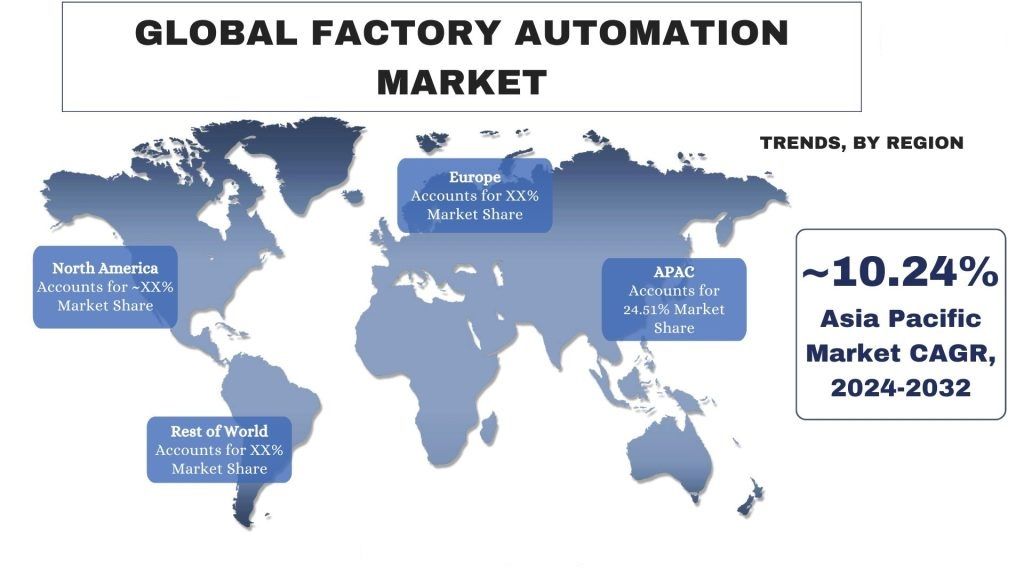
Przegląd branży automatyzacji fabryk
Rynek automatyzacji fabryk jest konkurencyjny i rozdrobniony, z obecnością kilku globalnych i międzynarodowych graczy rynkowych. Kluczowi gracze przyjmują różne strategie wzrostu, aby zwiększyć swoją obecność na rynku, takie jak partnerstwa, umowy, współpraca, wprowadzenia nowych produktów, ekspansje geograficzne oraz fuzje i przejęcia. Niektórzy z głównych graczy działających na rynku to ABB; Emerson Electric Co.; Siemens; Schneider Electric; Mitsubishi Electric Corporation; Yokogawa Electric Corporation; Honeywell International Inc.; Rockwell Automation; General Electric Company; i Robert Bosch GmbH.
Wiadomości z rynku automatyzacji fabryk
- 24 kwietnia 2024 r. Muller Technology ogłosiła plany wprowadzenia niestandardowych mobilnych systemów robotycznych na wystawie NPE 2024 w dniach 6-10 maja. Rozwiązania te mają na celu rozwiązanie problemu niedoboru siły roboczej w amerykańskim przemyśle przetwórstwa tworzyw sztucznych przy jednoczesnej poprawie wszechstronności, elastyczności, wydajności i produktywności. Nowe oferty firmy Muller obejmują Autonomiczne Roboty Mobilne (AMR) i Mobilne Manipulatory (MoMas), które, jak udowodniono, zwiększają produktywność i zmniejszają liczbę incydentów odnotowywanych przez OSHA.
- We wrześniu 2023 r., podczas China International Industry Fair (CIIF) 2023, firma ABB wprowadziła szeroki wybór najnowocześniejszych ofert automatyzacji robotyki, rozwiązań, oprogramowania i usług na swojej przestrzeni wystawienniczej o powierzchni 800 m2. Obejmowało to debiut dwóch nowych produktów: OptiFact™, początkowej modułowej platformy oprogramowania ABB, oraz nowego robota edukacyjnego IRB 1090.
Zakres raportu rynku automatyzacji fabryk
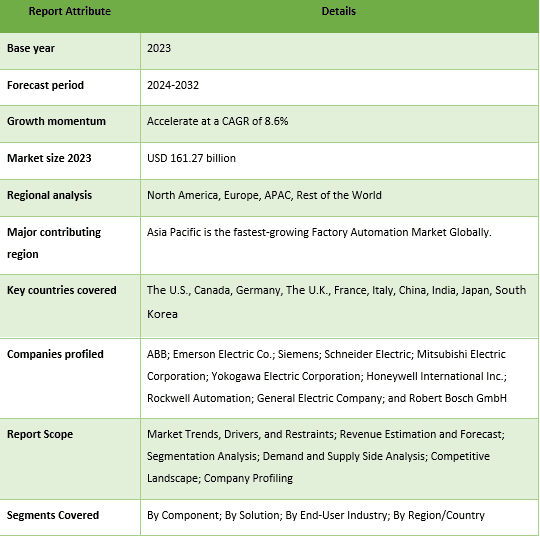
Zakres raportu rynku automatyzacji fabryk Powody, dla których warto kupić ten raport:
- Badanie obejmuje analizę wielkości i prognozy rynku, zatwierdzoną przez uwierzytelnionych kluczowych ekspertów branżowych.
- Raport przedstawia szybki przegląd ogólnych wyników branży na pierwszy rzut oka.
- Raport zawiera dogłębną analizę wybitnych rówieśników branżowych, ze szczególnym uwzględnieniem kluczowych danych finansowych, portfolio produktów, strategii ekspansji i ostatnich osiągnięć.
- Szczegółowe badanie czynników napędowych, ograniczeń, kluczowych trendów i możliwości występujących w branży.
- Badanie kompleksowo obejmuje rynek w różnych segmentach.
- Dogłębna analiza na poziomie regionalnym.
Opcje dostosowywania:
Globalny rynek automatyzacji fabryk można dodatkowo dostosować do wymagań lub dowolnego innego segmentu rynku. Poza tym UMI rozumie, że możesz mieć własne potrzeby biznesowe; dlatego skontaktuj się z nami, aby uzyskać raport, który w pełni odpowiada Twoim wymaganiom.
Spis treści
Metodologia badawcza dla analizy rynku automatyzacji fabryk (2024-2032)
Analiza rynku historycznego, oszacowanie obecnego rynku i prognozowanie przyszłego rynku globalnego rynku automatyzacji fabryk były trzema głównymi krokami podjętymi w celu stworzenia i analizy wdrożenia automatyzacji fabryk w głównych regionach na całym świecie. Przeprowadzono wyczerpujące badania wtórne w celu zebrania historycznych danych rynkowych i oszacowania obecnej wielkości rynku. Po drugie, aby zweryfikować te spostrzeżenia, wzięto pod uwagę liczne ustalenia i założenia. Ponadto przeprowadzono wyczerpujące wywiady pierwotne z ekspertami branżowymi w całym łańcuchu wartości globalnego rynku automatyzacji fabryk. Po założeniu i walidacji danych rynkowych za pośrednictwem wywiadów pierwotnych, zastosowaliśmy podejście top-down/bottom-up do prognozowania pełnej wielkości rynku. Następnie zastosowano metody podziału rynku i triangulacji danych w celu oszacowania i analizy wielkości rynku segmentów i podsegmentów branży. Szczegółowa metodologia została wyjaśniona poniżej:
Analiza historycznej wielkości rynku
Krok 1: Dogłębne badanie źródeł wtórnych:
Przeprowadzono szczegółowe badanie wtórne w celu uzyskania historycznej wielkości rynku automatyzacji fabryk za pośrednictwem wewnętrznych źródeł firmy, takich jaksprawozdania roczne i sprawozdania finansowe, prezentacje wyników, komunikaty prasowe itp.oraz źródła zewnętrzne, w tymczasopisma, wiadomości i artykuły, publikacje rządowe, publikacje konkurencji, raporty sektorowe, bazy danych stron trzecich i inne wiarygodne publikacje.
Krok 2: Segmentacja rynku:
Po uzyskaniu historycznej wielkości rynku automatyzacji fabryk, przeprowadziliśmy szczegółową analizę wtórną w celu zebrania historycznych informacji o rynku i udziałów dla różnych segmentów i podsegmentów dla głównych regionów. Główne segmenty są uwzględnione w raporcie, takie jak komponent, rozwiązanie i branża użytkownika końcowego. Przeprowadzono dalsze analizy na poziomie krajowym w celu oceny ogólnego wdrożenia modeli testowania w danym regionie.
Krok 3: Analiza czynnikowa:
Po uzyskaniu historycznej wielkości rynku różnych segmentów i podsegmentów, przeprowadziliśmy szczegółowąanalizę czynnikowąw celu oszacowania bieżącej wielkości rynku automatyzacji fabryk. Ponadto przeprowadziliśmy analizę czynnikową z wykorzystaniem zmiennych zależnych i niezależnych, takich jak komponent, rozwiązanie i branża użytkownika końcowego rynku automatyzacji fabryk. Przeprowadzono szczegółową analizę scenariuszy popytu i podaży, biorąc pod uwagę najważniejsze partnerstwa, fuzje i przejęcia, ekspansję biznesową i wprowadzenia produktów na rynku automatyzacji fabryk na całym świecie.
Szacowanie i prognoza bieżącej wielkości rynku
Określanie bieżącej wielkości rynku:Na podstawie praktycznych spostrzeżeń z powyższych 3 kroków, dotarliśmy do bieżącej wielkości rynku, kluczowych graczy na globalnym rynku automatyzacji fabryk oraz udziałów rynkowych segmentów. Wszystkie wymagane udziały procentowe, podziały i podziały rynku zostały określone przy użyciu wyżej wymienionego podejścia wtórnego i zostały zweryfikowane poprzez wywiady pierwotne.
Szacowanie i prognozowanie:Do szacowania i prognozowania rynku przypisano wagi do różnych czynników, w tym czynników napędowych i trendów, ograniczeń i możliwości dostępnych dla interesariuszy. Po przeanalizowaniu tych czynników zastosowano odpowiednie techniki prognozowania, tj. podejście z góry na dół/z dołu do góry, aby uzyskać prognozę rynkową na rok 2032 dla różnych segmentów i podsegmentów na głównych rynkach na całym świecie. Metodologia badawcza przyjęta do oszacowania wielkości rynku obejmuje:
- Wielkość rynku branży, pod względem przychodów (USD) i wskaźnik adopcji rynku automatyzacji fabryk na głównych rynkach krajowych
- Wszystkie udziały procentowe, podziały i podziały segmentów i podsegmentów rynku
- Kluczowi gracze na globalnym rynku automatyzacji fabryk pod względem oferowanych produktów. Ponadto strategie wzrostu przyjęte przez tych graczy, aby konkurować na szybko rozwijającym się rynku.
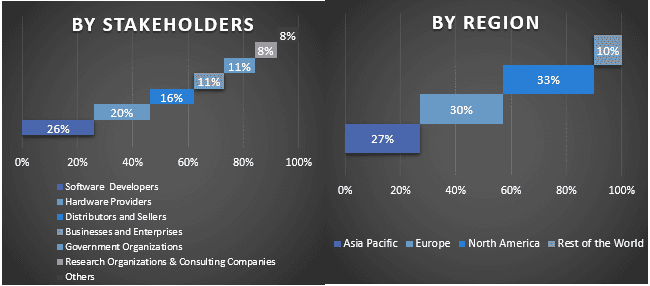
Wykres rynku automatyzacji fabryk
Walidacja wielkości i udziału w rynku
Badania pierwotne:Przeprowadzono dogłębne wywiady z kluczowymi liderami opinii (KOL), w tym dyrektorami najwyższego szczebla (CXO/Wiceprezesi, Szef Sprzedaży, Szef Marketingu, Szef Operacyjny, Szef Regionalny, Szef Krajowy itp.) w głównych regionach. Ustalenia z badań pierwotnych zostały następnie podsumowane, a analiza statystyczna została przeprowadzona w celu udowodnienia postawionej hipotezy. Dane z badań pierwotnych zostały skonsolidowane z ustaleniami wtórnymi, zamieniając tym samym informacje w praktyczne spostrzeżenia.
Podział uczestników pierwotnych w różnych regionach
Inżynieria rynku
Zastosowano technikę triangulacji danych w celu zakończenia ogólnego oszacowania rynku i uzyskania precyzyjnych danych statystycznych dla każdego segmentu i podsegmentu globalnego rynku automatyzacji fabryk. Dane podzielono na kilka segmentów i podsegmentów po przestudiowaniu różnych parametrów i trendów w obszarach komponentów, rozwiązań i branży użytkownika końcowego na globalnym rynku automatyzacji fabryk.
Główny cel badania globalnego rynku automatyzacji fabryk
W badaniu wskazano bieżące i przyszłe trendy rynkowe globalnego rynku automatyzacji fabryk. Inwestorzy mogą uzyskać strategiczne spostrzeżenia, aby oprzeć swoje decyzje inwestycyjne na analizie jakościowej i ilościowej przeprowadzonej w badaniu. Bieżące i przyszłe trendy rynkowe określiły ogólną atrakcyjność rynku na poziomie regionalnym, zapewniając platformę dla uczestników branżowych do wykorzystania niewykorzystanego rynku w celu skorzystania z przewagi pierwszego gracza. Inne cele ilościowe badań obejmują:
- Analiza bieżącej i prognozowanej wielkości rynku automatyzacji fabryk pod względem wartości (USD). Ponadto analiza bieżącej i prognozowanej wielkości rynku różnych segmentów i podsegmentów.
- Segmenty w badaniu obejmują obszary komponentów, rozwiązań i branży użytkownika końcowego.
- Zdefiniowanie i analiza ram regulacyjnych dla automatyzacji fabryk
- Analiza łańcucha wartości związanego z obecnością różnych pośredników, wraz z analizą zachowań klientów i konkurencji w branży
- Analiza bieżącej i prognozowanej wielkości rynku automatyzacji fabryk dla głównych regionów
- Główne kraje regionów objętych badaniem obejmują Azję i Pacyfik, Europę, Amerykę Północną i resztę świata
- Profile firm na rynku automatyzacji fabryk i strategie wzrostu przyjęte przez graczy rynkowych w celu utrzymania się na szybko rozwijającym się rynku.
- Dogłębna analiza branży na poziomie regionalnym
Najczęściej zadawane pytania FAQ
P1: Jaki jest aktualny rozmiar rynku i potencjał wzrostu globalnego rynku automatyzacji fabryk?
P2: Jakie są czynniki napędzające wzrost globalnego rynku automatyzacji fabryk?
P3: Który segment posiada główną część globalnego rynku automatyzacji fabryk według rozwiązania?
P4: Jakie są wschodzące technologie i trendy na globalnym rynku automatyzacji fabryk?
P5: Który region będzie najszybciej rosnącym globalnym rynkiem automatyzacji fabryk?
P6: Kto jest kluczowymi graczami na globalnym rynku automatyzacji fabryk?
Powiązane Raporty
Klienci, którzy kupili ten przedmiot, kupili również










